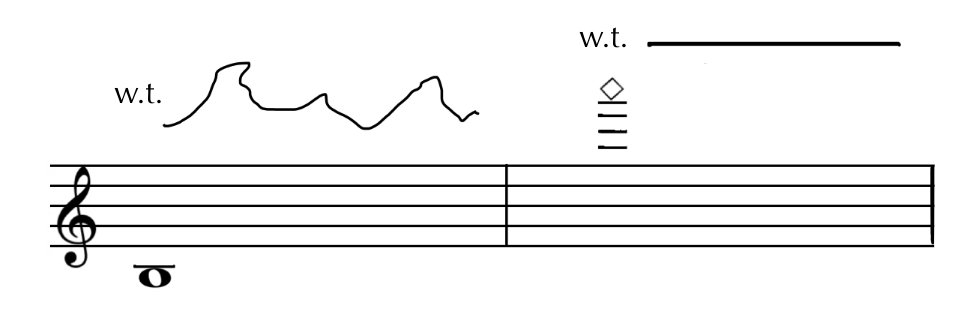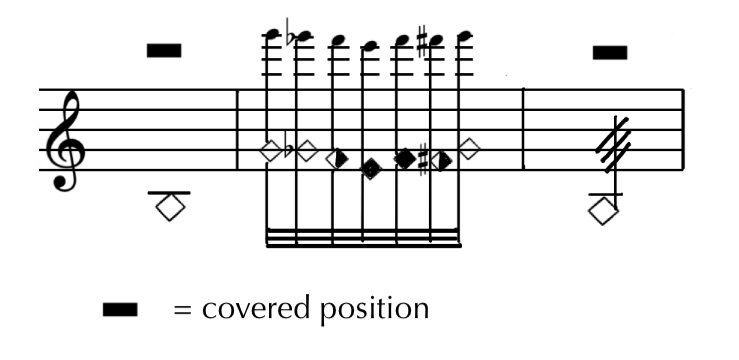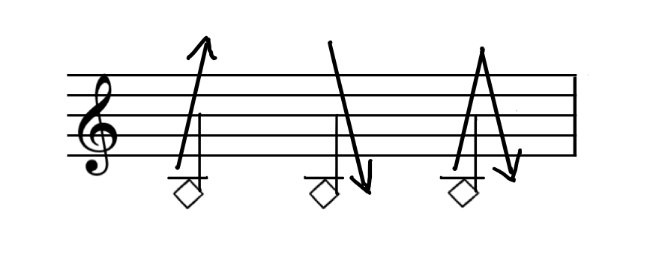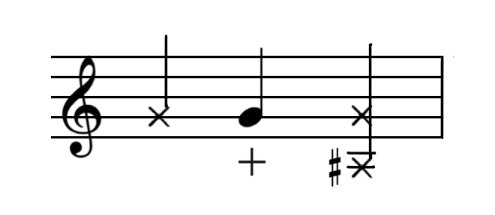Extended Technique Guide: Flute
This is an exploratory open resource for flute sounds that focuses on sonic examples and gives suggestions for notation.
Definition of extended:
Oxford Languages: 1) Made larger 2) Lasting longer than is usual or expected
Oxford English Dictionary: 1) Drawn out in length in space or time; continued, prolonged
Miriam Webster: 1) Drawn out in length, especially of time 2) Fully stretched out 3) Having spatial magnitude: being larger than a point
Many contemporary flutists reject the term “extended” as it is seen as pejorative, setting these sounds apart from a more standard approach to playing. While I agree that these techniques are a regular part of how to play the instrument, I do think “extended” is an accurate way to describe them. When we look at the definition of “extended,” we see that this term makes the world of the flute larger through space and time, making way for new worlds and unexpected timbres. This is an idea I support wholeheartedly. Extended also describes the way I approached writing this guide: to be an expansive description of each sound, inviting both the flutist and composer to look more deeply in ways that opens worlds within a single sound.
This text is NOT:
Unbiased. This is what I have found to be true for me and my body, how I prefer to make the sounds and view notation. In keeping with the idea of ‘extended,’ the language below balances specific physical descriptions with more expansive descriptions.
A replacement for speaking and working together with a living flutist. Music making is more fun and rewarding together.
The final say in how these sounds work or how they should be written. Each body is different and every context is unique. It is what has been consistently true for me. I have been careful with my language below to encourage keeping an open mind.
An invitation to write what I call an ‘everything but the kitchen sink’ piece with as many techniques as you can fit on the page. There is a dynamic world of sonic meaning within each category below; I invite you to linger within each world.
You WILL find:
Brief descriptions of sounds and how they are produced.
Short audio samples of the basic sound.
Considerations: dynamics, sonic limitations, and interesting features.
Experiments: further ways to vary the sound.
Extended audio samples of variations of each sound. (forthcoming)
Suggestions for music notation.
NOTE: There are many ways to notate these sounds and many can be notated in the same way. (Looking at you, air sounds!) Consider the context clues of your sound in addition to your own writing style. The examples below were hand-drawn on an iPad with the forScore app and customized stamps.
Practice Tips: for some of the more challenging sounds, these are common strategies that help most flutists find their way.
Questions? Concerns?
Just ask me: rachelbeetz@gmail.com
Pitched Air Sounds
White noise / airy sound on an indicated pitch. Instead of playing with tone, the flutist blows air with looser lips in a more diffused airstream.
Considerations: pp -> mf
Carries a similar flexibility to toned playing in the variation of timbre and dynamics, but with a limited range of expression.
Limited pitch range to the first octave of the flute because there is no overtone series present in the undefined airstream to create the upper octaves.
Air sounds on pitches above the first octave need to include some tone sound in order to distinguish them from the lower octave. (If you have a different answer to this - please write to me!)
Experiments:
Vary vowel shapes
Speed / Volume of air
Sustained fricatives such as ‘sh,’ ‘ch,’ ‘k,’ etc. or fluttertongue
Timbre spectrum between tone and air sound
Long durations: circular breathing is easier as the sound does not require a tensioned embouchure.
It is especially interesting on the bass flute!
WHISTLE TONES
A high-pitched whistle sound created by blowing extremely slow air with a small, defined aperture and very still lips. Change pitches of the overtone series by subtly changing the shape of the mouth cavity and position of the tongue.
Considerations: ppp
Very delicate and fragile!
Challenging to orchestrate in ensemble music becuase they are so quiet.
Even the most practiced flutist may have trouble with steady whistle tones in the context of performance. They require small muscles of the body to be completely still and sometimes the involuntary muscles of the body, like the heart, create sympathetic movement in the body. It is best to be open to and/or expect some wavering.
Experiments:
A steady whistle is easier to achieve with upper register fingerings or blowing through the flute (see next technique).
First octave notes and the lowest notes have more overtone variation for wavering whistles.
Vary the overtone series over wavering whistles by using microtonal or multiphonic fingerings.
Practice tip: If struggling to make these delicate sounds, greatly reduce the speed of air to almost no pressure whatsoever. Think of the hot air next to a radiator.
Air Sounds Through the Flute
White noise, air sound with a less prominent pitch is performed by completely covering the embouchure opening and blowing through the tube.
Considerations: pp
Quieter than the pitched air sounds explained above.
It takes time for the flutist to get into the position of covering the embouchure hole. Fast transitions between the standard playing position on the chin and this covered position are risky. (Yes, I have smacked my teeth with my flute in a concert, several times, actually.)
Experiments:
Whistle variation: it is possible to incorporate a high-pitched whistle tone. These are easier to control in the steady state, but cannot be performed for as long as a traditional whistle tone because they require blowing more air through the flute
Practice Tip: Two methods of production. One may be easier for a flutist than another, depending on their anatomy. The flutist should choose the one for them, since there isn’t a huge difference in sound.
Place the tip of your upper lip slightly into the embouchure hole of the flute to create a whistle effect.
Place the tip of a u-shaped tongue slightly over the bottom part of the embouchure hole of the flute. (I have never really mastered this way, but have a colleague where this is their preferred method and they sound amazing!)
Growl / Flutter Tongue: Make a rolled ‘r’ sound while blowing and it will sound like a growl. This is an awesome sound on the bass flute. (My favorite trick to show kids!)
Trumpet Embouchure: buzz your lips like a brass instrument into the embouchure hole. This is more effective and controllable to me when you take off the headjoint and just use the body/foot of the flute.
JET WHISTLE
White noise ‘jet’ sound made by blowing a large amount of fast air quickly through the tube
Considerations: ppp->ff
The pitch of this air sound is the overtone series of the indicated fingering (sort of)
Lower notes produce louder and more harmonically complex sounds with a wider dynamic and expression range
Higher notes produce harsher sounds that have a more limited range of expression
Having many of these in a row will need to be cared for dynamically since each one, even quiet ones, can take an entire breath of air. (Don’t pass out!)
Experiments:
You can control the starting and ending point of the sound, going from the top of the overtone series down or vice versa, or both directions by combining the covered embouchure technique from above with either your top lip or your tongue.
Vary the rate of change, going slowly through the overtones. (This will probably be more limited in dynamic range or due to the volume and speed of air necessary to make this sound loud.)
Vary the dynamic range, try making very quiet jet whistles vs. very loud ones
Practice Tip: It helps to create the higher portion of the jet whistle with a similar technique to the Whistle Variation of Air Sounds through the flute listed above: By introducing a portion of either the upper lip (what I do) or tip of the tongue into the embouchure hole of the tube, depending on what works with the player’s anatomy. Almost every jet whistle I perform has my upper lip covering a portion of the embouchure hole in varying amounts.
Key Click
A short percussive sound on an indicated pitch
Considerations: pp -> mp
A note on damage: I have noticed that when I am working on a piece with frequent, loud key clicks I need to get my flute serviced more regularly and therefore often choose to use my less professional instrument to practice these pieces. It is a repairable damage, but it does cost the flutist money.
Limited pitch range to just over the first octave of the flute.
Lower notes are louder than higher ones.
Experiments:
Play key clicks alongside a pitched note, though depending on the note, consider the dynamic balance between the pitched sound and the key click
Covering the embouchure hole of the flute results in pitches that are a major 7th lower
Vary the density from a spare single click to a chattering of activity.
The low flutes (alto, bass, etc) make louder key clicks.
Consider amplification with a specialized microphone placement near the keys or end of the tube.
Tongue pizzicato
A percussive snapping sound made with the tongue flipping against the hard palate resonating through the tube of the flute. Our version of a string ‘pizzicato.’
Considerations: pp->ff
Limited range to just over the first octave
Lower notes are louder (they have more sound resonating through the long tube)
Fast repetitions are usually not max volume.
Practice Tip: In fast repetitions, try changing the technique to a hard ‘d’ instead of flipping the tongue
How I was taught (anyone can do it!)
Place bottom of your tongue on your hard palate at the top of your mouth.
Take a breath in and hold it, building breath support pressure
Without actively blowing air, flip your tongue against the hard palate back to its unfolded state.
You’ll notice air escapes, but you haven’t actively blown the air.
The first couple of times will sound a bit ‘sloppy’ and eventually you’ll develop strength in the tongue muscle. You also don’t need to have any air to do this, but it helps to feel the breath support when you’re learning.




